
Joseph Mallord William Turner, known in his time as William Turner, was an English Romantic painter, printmaker and watercolourist. He is known for his expressive colouring, imaginative landscapes and turbulent, often violent marine paintings. He left behind more than 550 oil paintings, 2,000 watercolours, and 30,000 works on paper. He was championed by the leading English art critic John Ruskin from 1840, and is today regarded as having elevated landscape painting to an eminence rivalling history painting.
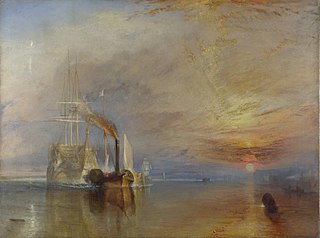
The Fighting Temeraire, tugged to her last berth to be broken up, 1838 is an oil-on-canvas painting by the English artist Joseph Mallord William Turner, painted in 1838 and exhibited at the Royal Academy in 1839.
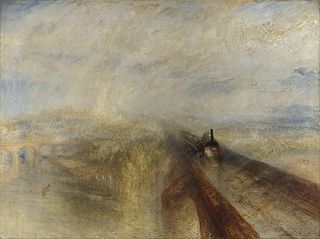
Rain, Steam, and Speed – The Great Western Railway is an oil painting by the 19th-century British painter J. M. W. Turner.

George Jones was a British painter, and Keeper of the Royal Academy, most famous for his paintings of military subjects.

Light and Colour – The Morning after the Deluge – Moses Writing the Book of Genesis is an oil painting by the English painter Joseph Mallord William Turner (1775–1851), first exhibited in 1843.

The Burning of the Houses of Lords and Commons, 16th October, 1834 is the title of two oil on canvas paintings by J. M. W. Turner, depicting different views of the fire that broke out at the Houses of Parliament on the evening of 16 October 1834. They are now in the Philadelphia Museum of Art and Cleveland Museum of Art.

Snow Storm: Hannibal and his Army Crossing the Alps is an oil on canvas painting by J. M. W. Turner, first exhibited in 1812. Left to the nation in the Turner Bequest, it was acquired by the National Gallery in London in 1856, and is now held by the Tate Gallery.

Dido building Carthage, or The Rise of the Carthaginian Empire is an oil on canvas painting by J. M. W. Turner. The painting is one of Turner's most important works, greatly influenced by the luminous classical landscapes of Claude Lorrain. Turner described it as his chef d'oeuvre. First exhibited at the Royal Academy summer exhibition in 1815, Turner kept the painting until he left it to the nation in the Turner Bequest. It has been held by the National Gallery in London since 1856.
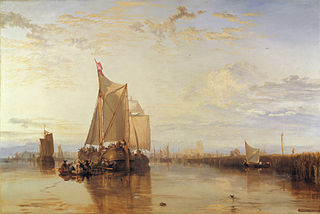
The Dort, or Dort or Dordrecht: The Dort packet-boat from Rotterdam becalmed is an 1818 painting by J. M. W. Turner, based on drawings made by him in mid September 1817. It shows a view of the harbour of Dordrecht. It is the finest example of the influence of Dutch marine painting on Turner's work.

Fishermen at Sea, sometimes known as the Cholmeley Sea Piece, is an early oil painting by English artist J. M. W. Turner. It was exhibited at the Royal Academy in 1796 and has been owned by the Tate Gallery since 1972. It was the first oil painting by Turner to be exhibited at the Royal Academy. It was praised by contemporary critics and burnished Turner's reputation, both as an oil painter and as a painter of maritime scenes.

War. The Exile and the Rock Limpet is an oil painting of 1842 by the English Romantic painter J. M. W. Turner (1775–1851). Intended to be a companion piece to Turner's Peace - Burial at Sea, War is a painting that depicts a moment from Napoleon Bonaparte's exile at Saint Helena. In December 1815, the former Emperor was taken by the British government to the Longwood House, despite its state of disrepair, to live in captivity; during his final years of isolation, Napoleon had fallen into despair. Turner's decision to pair the painting with Peace was heavily criticized when it was first exhibited but it is also seen as predecessor to his more famous piece Rain, Steam and Speed – The Great Western Railway (1844).

Norham Castle, Sunrise is an oil-on-canvas painting by English painter J. M. W. Turner, created around 1845. The painting depicts Norham Castle, overlooking the River Tweed, the border between England and Scotland. The painting was bequeathed to the National Gallery of British Art as part of the Turner Bequest in 1856. It remains in the collection to this day. It was one of the artist's last paintings, and falls within his "Modernist" period. This piece is well known for Turner's attentiveness to dawn light, and the softened silhouette it brings.

The Golden Bough is a painting from 1834 by the English painter J. M. W. Turner. It depicts the episode of the golden bough from the Aeneid by Virgil. It is in the collection of the Tate galleries.
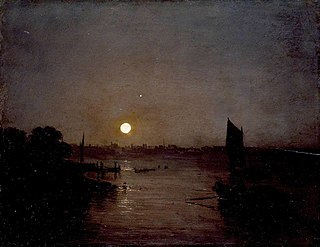
Moonlight, a Study at Millbank is an oil painting by J. M. W. Turner, painted c. 1797. The nocturne is painted in oils on a mahogany board which measures 31.4 cm × 40.3 cm. It has been held by the Tate Gallery since 1910.

Peace – Burial at Sea is a painting in oils on canvas by the English Romantic artist J. M. W. Turner (1775–1851), first exhibited in 1842. The work is a memorial tribute to Turner's contemporary the Scottish painter Sir David Wilkie (1786–1841). The canvas depicts Wilkie's burial at sea. This work was intended as a companion piece to War. The Exile and the Rock Limpet which alludes to the sordid demise of the former Emperor of France Napoleon Bonaparte. The two works are characterized by sharply contrasting colors and tones: War utilizes a strident yellow and red while Peace is painted a cool blend of white, blue and black.

The Shipwreck is a landscape painting by J. M. W. Turner in the collection of the Tate. It was completed around 1805, when it was exhibited in Turner's own gallery. The painting is an important example of the sublime in British art.
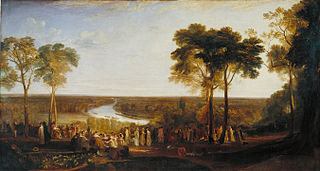
England: Richmond Hill, on the Prince Regent's Birthday is an 1819 painting by the English artist J. M. W. Turner. It was displayed at the 1819 Royal Academy Summer Exhibition at Somerset House, the largest work that Turner had yet presented. It depicts a real event on Richmond Hill hosted by Lady Cardigan at Cardigan House on 12 August 1817 to celebrate the birthday of the Prince Regent. Petersham Meadows by the bend in the River Thames is in the background. Just across the river in Twickenham was Turner's own house Sandycombe Lodge. Ham House is also visible in the distance. The work appears to show the Regent just off the canvas as several of the guests turn to look. Turner's biographer James Hamilton describes it as featuring "flighty Watteauesque figures, ideal evanescent trees, and a horizon so extended as to be unreal". It may have been an attempt to secure the Regent's patronage. He did subsequently receive his only royal commission for the naval painting The Battle of Trafalgar in 1822.

London from Greenwich Park is an 1809 landscape painting by the English artist J. M. W. Turner. It looks down from Greenwich Hill towards Greenwich Hospital and the Queen's House. In the distance beyond the River Thames is the City of London with St Paul's Cathedral towering over the other buildings. It emphasises the extent of the capital as an expanding metropolis. It replicates a similar view by the Dutch painter Hendrick Danckerts dating back to 1670.

Childe Harold's Pilgrimage – Italy is an 1832 landscape painting by the British artist J. M. W. Turner. It depicts a scene from the poem Childe Harold's Pilgrimage by Lord Byron. Turner possibly drew some inspiration from his friend Charles Lock Eastlake's 1827 painting Lord Byron's Dream. It also reflects the influence of the seventeenth century artist Claude Lorrain.

The Funeral of Sir Thomas Lawrence is an 1830 watercolour painting by the British artist J. M. W. Turner. It depicts the funeral at St. Paul's Cathedral in London of Sir Thomas Lawrence, the President of the Royal Academy and a friend and colleague of Turner. Lawrence died unexpectedly in January, and the painting captures the snow-covered landscape of his burial ceremony. Turner served as one of the pallbearers and sketched the scene from memory. It was exhibited at the Royal Academy's Summer Exhibition. It was later part of the 1856 Turner Bequest as is now in the collection of the Tate Britain.




















